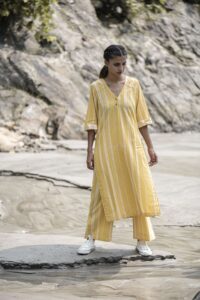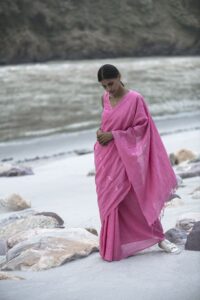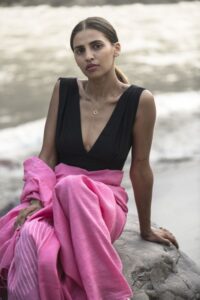How two NIFT graduates set up a sustainable fashion brand

Taruna Sharma
The brainchild of two NIFT graduates, Prerna & Jayant, Kavana was launched in March, 2020, just before the first Lockdown happened. Right from the time when the two business partners were exposed to the world of fashion, they had a firm belief that there was a dire need for a shift in how a traditional fashion business is run. The two also wanted more involvement of artisans in mainstream fashion.
Started on a bootstrapped budget with an initial investment of Rs 2 lakh, the brand is working in close association with artisanal communities like Bhujodi (weavers of kala cotton, natural dyers), Ajrakhpur (ajrakh printing), Bhagalpur (weavers of linen and silk), Habibpur (jamdani weavers and natural dyers in West Bengal), Phulia (jamdani weavers of West Bengal) and Bhopal (hand painting on sari and natural dyers).
Kavana began with saris as “it signifies the Indian way of living and is undoubtedly the most sustainable piece of clothing”. Only recently has it launched a range of dresses, co-ords, kurtas and tunics.


The beginning
The journey of last 18 months has been immensely challenging but satisfying. “Since we launched our brand during a pandemic, to sustain our business and to fulfil the purpose of supporting the artisans was an even bigger of a challenge. But we have been very grateful with the kind of support our audience has given us in such a small time and hence keeping our brand and purpose afloat during such tough times,” says Prerna.
To work with natural dyes has been a challenge, as there is a limitation in the variety of colour you can obtain using it. But through a lot of experimentation along with the artisans, Kavana now has a wide range of colours under its catalogue which are all dyed using vegetable and plants.
Sustainable brand
Sustainability is way of life where you are conscious of your actions and how they affect the environment around you – something has always been a core part of Indian way of life.
“At Kavana, we did a lot of research to understand the practices which are eco-friendly, and then implemented those throughout our supply chain,” says Prerna. “Plus, we are transparent with our audience, be it processes or materials,” puts in Jayant, adding that these practices have stood them in good stead.
“Our products are crafted using traditional methods, but the designs and silhouettes are very contemporary which appeals to the fashion forward young audience,” says Prerna.
Promoting sustainable fashion among people was a challenge, both agree. But continuous conversations around the subject helped a great deal. “Our efforts have seen an imminent shift in mind-set of how people chose to invest in fashion,” says Jayant, a trifle proud.
Cost Vs Quality
The affordability and cost is decided by two factors. The first one is dependent on the making cost, which is high since handcrafted and sustainable fashion needs more time and better quality material to produce. “Everything we make is dyed using natural/vegetable dyes and has zero chemicals,” says Prerna. “That accounts for the high making cost. Natural dyes take 4-5 times more time to execute than chemical dye and hence are more costly,” says Jayant, “but as people become more aware and demand for the handcrafted pieces rises, the prices are bound to drop. The sellers can then reduce their margins and still survive.”
Future plans
We want to be the leaders in India. We wish to gradually increase our product line and make sustainable products accessible to a larger population of the country. “Soon, we will be launching a new video series focussing on promoting the Indian textile arts and crafts while also following sustainable practices in fashion,” says Prerna.



1 Comment
congrats to NIFT graduates, for setting up sustainable fashion brand Kavana